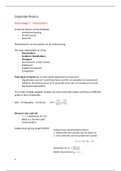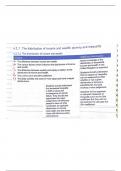Corporate finance
Hoorcollege 1 - Introduction
Corporate finance vooral bruikbaar:
- Investment banking
- Security issues
- Research
Maximaliseren van de waarde van de onderneming.
The main stakeholders of a firm:
- Shareholders
- Creditors/ Bondholders
- Managers
- Government/ society (taxes)
- Employees
- Suppliers/customers
- Competitors
Time value of money ($1 is more worth today than $1 next year)
- Opportunity costs ($1 could have been used for consumption or investment)
- Inflation(Purchasing power of $ 1 generally lower due¿increasing price levels)
- Risk-based explanations
In order to build valuation models, we need a tool that makes cash flows at different
points in time comparable.
CF 1 CF 2
NPV = PV (benefits) – PV (costs) PV = +
1+ r 1 ¿ ¿
Discount rates and risk
- r = r f +adjustment for risk
- What is a risk free rate?
- Compensation
Capital asset pricing model (CAPM)
1
,Free cash flows (FCF)
What is de main difference between the two concepts (financial and accounting method)
Operating income
- Revenue
- Costs
Net investments
Taxes
FCF = Revenue – costs – investments – taxes
= ( 1−❑c )∗EBIT + depriciation−Investment
Most of the time in this course linear depreciation.
Working capital management
Verschil tussen vlottende passiva (crediteuren, kortlopende schulden) en vlottende activa
(debiteuren, voorraden, operationele kasstroom). (NWC)
+ A company running out of liquidity runs a high risk of bankruptcy
+ Keep capacity that always allows you to service your customers
- Maintaining liquidity of assets binds costly capital
⇒ Trade-off that requires active management
Cash and operating cycle
Cash convenience cycle (CCC)
2
,Trade credit
De mogelijkheid geven aan een klant om op een later tijdstip te betalen voor een product/
dienst. Wanneer je niet meteen betaald als je een product in ontvangst neemt.
- Leveranciers geven klanten credit wanneer goederen worden aangeschaft
- B2C ook mogelijk, maar B2B flexibeler. (Debiteuren, crediteuren)
- Trade credit voorwaarden bepaald in contract: tijd, eventuele korting bij eerdere
betaling, rente bij niet betalen binnen termijn
Managen en controle accounts receivables en accounts payable.
- Voorwaarden (gemiddeld aantal dagen, kortingen)
- Risico’s (herstructureren organisatie)
Inventory management
- Voorkom uitputting van voorraden
- Buffer
- Actief voorraden management helpt bij controle
3
,Hoorcollege 2 Modigliani Miller
Financial securities:
- Debt
o Short-term vs long-term debt
o Public vs private/ generally bank debt (what kind of debt is it)
- Common Shares/Equity
Capital structure
Hoe financiert een onderneming haar assets. Focus in dit college ligt bij de debt-equity-ratio,
hefboom. Boekwaarde en marktwaarde van een schuld. Mix van debt en equity. Debtholders
en equity holders.
Maximaliseren waarde onderneming of minimaliseren cost of capital (WACC)
MM proposition 1 (perfect capital market with no taxes)
In perfect capital markets, the total value of a firm is independent of the firm’s capital
structure. The total value of a firm is equal to the market value of the cash flows generated
by its assets. Implications:
- Value levered firm = Value unlevered (share price is constant (levered or unlevered,
price remains the same)
- Value of any firm = EBIT(1-t) / WACC ((r A ), WACC is constant) = FCF/WACC
D E
- WACC = ∗r D + ∗r E Unlevered: debt = 0, E = V. WACC = return on equity (r U )
V V
MM proposition 2 (No tax)
D
Return of equity (Re) increases with more leverage R E=R A + ( R −R D )
E A
The equity cost of capital is
- Linearly increasing in leverage
- By a factor that is equal to the difference between the average cost of capital and the
debt cost of capital
- More leverage increases risk of equity, gains/ losses are magnified.
Assumptions:
Financial transactions generate zero NPV
- Financial markets are competitive
o All market participants are not providing a scarce security.
o They are price-takers and cannot charge a price premium due to potential
market power.
- Financial markets are complete
o This assumption is important because it allows investors to build replicating
portfolios, as seen in the MM proof.
o Otherwise, arbitrageurs may not be able to exploit potential mispricing of
equity-financed and debt-financed firms.
4
, o There are no distortionary transaction costs between debt and equity
financing.
o ⇒ Otherwise, one financing method may have a valuable advantage and MM
breaks down.
- Financial markets are strong-form efficient
Main subjects:
- No taxes
- No cost of financial distress
- No issuance cost
- No agency conflicts between managers and investors
Financial Markets
Investment bank offers two options to the entrepreneur:
- Issue equity return of 20% (increase equity, lower debt pay-off debt)
- Issue risk-free debt claim is 5%
Equity financing
5
Hoorcollege 1 - Introduction
Corporate finance vooral bruikbaar:
- Investment banking
- Security issues
- Research
Maximaliseren van de waarde van de onderneming.
The main stakeholders of a firm:
- Shareholders
- Creditors/ Bondholders
- Managers
- Government/ society (taxes)
- Employees
- Suppliers/customers
- Competitors
Time value of money ($1 is more worth today than $1 next year)
- Opportunity costs ($1 could have been used for consumption or investment)
- Inflation(Purchasing power of $ 1 generally lower due¿increasing price levels)
- Risk-based explanations
In order to build valuation models, we need a tool that makes cash flows at different
points in time comparable.
CF 1 CF 2
NPV = PV (benefits) – PV (costs) PV = +
1+ r 1 ¿ ¿
Discount rates and risk
- r = r f +adjustment for risk
- What is a risk free rate?
- Compensation
Capital asset pricing model (CAPM)
1
,Free cash flows (FCF)
What is de main difference between the two concepts (financial and accounting method)
Operating income
- Revenue
- Costs
Net investments
Taxes
FCF = Revenue – costs – investments – taxes
= ( 1−❑c )∗EBIT + depriciation−Investment
Most of the time in this course linear depreciation.
Working capital management
Verschil tussen vlottende passiva (crediteuren, kortlopende schulden) en vlottende activa
(debiteuren, voorraden, operationele kasstroom). (NWC)
+ A company running out of liquidity runs a high risk of bankruptcy
+ Keep capacity that always allows you to service your customers
- Maintaining liquidity of assets binds costly capital
⇒ Trade-off that requires active management
Cash and operating cycle
Cash convenience cycle (CCC)
2
,Trade credit
De mogelijkheid geven aan een klant om op een later tijdstip te betalen voor een product/
dienst. Wanneer je niet meteen betaald als je een product in ontvangst neemt.
- Leveranciers geven klanten credit wanneer goederen worden aangeschaft
- B2C ook mogelijk, maar B2B flexibeler. (Debiteuren, crediteuren)
- Trade credit voorwaarden bepaald in contract: tijd, eventuele korting bij eerdere
betaling, rente bij niet betalen binnen termijn
Managen en controle accounts receivables en accounts payable.
- Voorwaarden (gemiddeld aantal dagen, kortingen)
- Risico’s (herstructureren organisatie)
Inventory management
- Voorkom uitputting van voorraden
- Buffer
- Actief voorraden management helpt bij controle
3
,Hoorcollege 2 Modigliani Miller
Financial securities:
- Debt
o Short-term vs long-term debt
o Public vs private/ generally bank debt (what kind of debt is it)
- Common Shares/Equity
Capital structure
Hoe financiert een onderneming haar assets. Focus in dit college ligt bij de debt-equity-ratio,
hefboom. Boekwaarde en marktwaarde van een schuld. Mix van debt en equity. Debtholders
en equity holders.
Maximaliseren waarde onderneming of minimaliseren cost of capital (WACC)
MM proposition 1 (perfect capital market with no taxes)
In perfect capital markets, the total value of a firm is independent of the firm’s capital
structure. The total value of a firm is equal to the market value of the cash flows generated
by its assets. Implications:
- Value levered firm = Value unlevered (share price is constant (levered or unlevered,
price remains the same)
- Value of any firm = EBIT(1-t) / WACC ((r A ), WACC is constant) = FCF/WACC
D E
- WACC = ∗r D + ∗r E Unlevered: debt = 0, E = V. WACC = return on equity (r U )
V V
MM proposition 2 (No tax)
D
Return of equity (Re) increases with more leverage R E=R A + ( R −R D )
E A
The equity cost of capital is
- Linearly increasing in leverage
- By a factor that is equal to the difference between the average cost of capital and the
debt cost of capital
- More leverage increases risk of equity, gains/ losses are magnified.
Assumptions:
Financial transactions generate zero NPV
- Financial markets are competitive
o All market participants are not providing a scarce security.
o They are price-takers and cannot charge a price premium due to potential
market power.
- Financial markets are complete
o This assumption is important because it allows investors to build replicating
portfolios, as seen in the MM proof.
o Otherwise, arbitrageurs may not be able to exploit potential mispricing of
equity-financed and debt-financed firms.
4
, o There are no distortionary transaction costs between debt and equity
financing.
o ⇒ Otherwise, one financing method may have a valuable advantage and MM
breaks down.
- Financial markets are strong-form efficient
Main subjects:
- No taxes
- No cost of financial distress
- No issuance cost
- No agency conflicts between managers and investors
Financial Markets
Investment bank offers two options to the entrepreneur:
- Issue equity return of 20% (increase equity, lower debt pay-off debt)
- Issue risk-free debt claim is 5%
Equity financing
5




